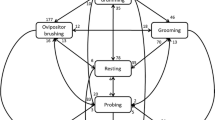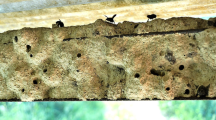Summary.
In West- and East-Malaysian lowland rainforests, three Pseudolasius spp. are found in trophobiotic relationship with a total of eight scale insect species in six genera feeding at the roots of plants. Intimate associations going beyond pure trophobiosis could be discovered with five species of root mealybugs: Planococcoides sp., Maconellicoccus multipori (Takahashi) and three species of Rhizoecus. All three Pseudolasius species carry their pseudococcids 1. when disturbed, 2. during nest movements, and 3. to feeding sites. Moreover, the Pseudolasius species under discussion permanently keep adults and immature instars of their mealybug partners within their nests.¶Pseudolasius spp. are highly polydomous, which results in an extremely decentralized colony structure. Numerous small nest chambers were either widely distributed in the top soil (Pseudolasius sp. 2 and sp. 3) or predominantly in small decaying twigs (Pseudolasius sp.1). Pseudolasius sp.1 and Pseudolasius sp. 2 are polygynous. Of Pseudolasius sp. 3 we found only one queen, but polygyny is highly probable as well. Mealybug-carrying or phoresis during mating flights could not be observed. Nevertheless, Pseudolasius sp.1 was found associated with Rhizoecus sp. #21, being widely distributed in the humus layer from 600 m a.s.l. up to 1140 m a.s.l. (at Mt. Kinabalu, Sabah, East-Malaysia). In 81.7% of the nests, Rhizoecus sp. #21 was present. Preferences for certain mealybug species were detected for Pseudolasius sp. 1, P. sp. 2 and P. sp. 3 in West-Malaysia as well. Consequently the question arises how the simultaneous distribution of both partners is achieved.¶For the co-dispersal of Pseudolasius spp. and their pseudococcids we suppose queen adoption and permanent colony fission take place, possibly combined with claustral colony foundation and the help of independently gained root trophobionts.
Similar content being viewed by others
Author information
Authors and Affiliations
Additional information
Received 5 February 2001; revised 22 April 2001; accepted 3 May 2001.
Rights and permissions
About this article
Cite this article
Malsch, A., Kaufmann, E., Heckroth, HP. et al. Continuous transfer of subterranean mealybugs (Hemiptera, Pseudococcidae) by Pseudolasius spp. (Hymenoptera, Formicidae) during colony fission?. Insectes soc. 48, 333–341 (2001). https://doi.org/10.1007/PL00001786
Issue Date:
DOI: https://doi.org/10.1007/PL00001786




